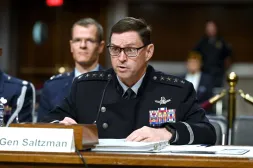Hegseth issues edict on DOD software acquisition

Secretary Pete Hegseth is directing all Defense Department components to embrace a rapid software acquisition pathway and use commercial solutions opening and Other Transaction authority to speed up the procurement of digital tools for warfighters.
The department’s Software Acquisition Pathway, or SWP, was set up during the first Trump administration under then Undersecretary of Defense for Acquisition and Sustainment Ellen Lord as part of a broader push for a so-called Adaptive Acquisition Framework that enables the department to procure software differently than it buys hardware. Programs on that pathway are not subject to some of the encumbrances associated with the Joint Capabilities Integration and Development System and major defense acquisition program designations.
“Programs using the software acquisition pathway will demonstrate the viability and effectiveness of capabilities for operational use not later than 1 year after the date on which funds are first obligated to develop the new software capability. New capabilities will be delivered to operations at least annually to iteratively meet requirements, but more frequent updates and deliveries are encouraged where practical,” according to DOD Instruction 5000.87 issued in October 2020.
The instruction also requires government and contractor software teams to use modern iterative software development methods such as DevSecOps.
Now, Hegseth wants to make sure all DOD components are taking advantage of the pathway.
“Software is at the core of every weapon and supporting system we field to remain the strongest, most lethal fighting force in the world. While commercial industry has rapidly adjusted to a software-defined product reality, DoD has struggled to reframe our acquisition process from a hardware-centric to a software-centric approach. When it comes to software acquisition, we are overdue in pivoting to a performance-based outcome and, as such, it is the Warfighter who pays the price,” he wrote in a March 6 memo addressed to senior leaders, combatant commanders, and agency and field activity directors.
To address the problem, Hegseth is decreeing that all DOD components must adopt the SWP as the “preferred pathway for all software development components of business and weapon system programs.”
“This will enable us to immediately shift to a construct designed to keep pace with commercial technology advancements, leverage the entire commercial ecosystem for defense systems, rapidly deliver scaled digital capabilities, and evolve our systems faster than adversaries can adapt on the battlefield,” he wrote.
As the U.S. military pursues new AI tools — a tech pursuit which Hegseth is prioritizing as the department moves to modernize for potential fights against advanced adversaries — software is expected to become even more critical.
To get software vendors on contract faster and cut through bureaucratic red tape, the Pentagon chief also wants DOD components to leverage commercial solutions openings — a solicitation mechanism that the Silicon Valley-headquartered Defense Innovation Unit has been using to bring commercial firms into the Pentagon’s acquisition fold — and Other Transaction agreements, which allow for rapid prototyping and follow-on production contracts for new tech.
However, Pentagon officials have noted that acquisition offices and contracting officers don’t always use or aren’t aware of some of these tools that are available to them, instead relying on more traditional processes associated with federal acquisition regulations.
“Effective immediately, for efforts that meet the threshold requirements enabling the application of authorities provided at title 10, U.S.C., § 3458 or title 10, U.S.C., § 4022, I am directing the use of Commercial Solutions Openings and Other Transactions as the default solicitation and award approaches for acquiring capabilities under the SWP. This applies to any software pathway program in the planning phase prior to execution. Department Components are prohibited from implementing further guidance on this point that would set out restrictive measures, guidelines, frameworks, directives, or policies other than required by statute,” Hegseth wrote.
“The reason this works better [is that] instead of spending years writing detailed requirements and going through a rigid … one-size-fits-all process, we can tap into the best tech available right now, prototype it fast and get it to the field quickly, if it works,” a defense official told reporters during a background call Friday regarding Hegseth’s directive. “So bottom line, we’re cutting out middlemen. Software companies make software. We’re going to buy software from software companies.”
Another senior defense official noted the importance of combining SWP with the commercial solutions opening and OTAs.
“The challenge with that software pathway is that it did nothing in and of itself for how we expose commercial, nontraditional vendors who are also developing innovative software to those software programs. So when we take that software pathway mechanism and we combine it with innovation that DIU has been working in commercial solutions openings, or CSOs, and other transaction authorities, OTAs, we get to the point where now we can expose the programs, the software programs, to nontraditional and commercial software developers, while we simultaneously … lower the barrier for those nontraditional and commercial software developers to get into defense programs of record,” they said.
As an example of the effectiveness of leveraging these types of mechanisms, a senior defense official noted that since 2016, DIU has awarded more than 500 OTAs using the commercial solutions opening process. About 88 percent of those deals went to nontraditional vendors and 68 percent to small businesses. The unit’s goal is to get vendors on contract in less than 90 days.
“This … [Hegseth] memo is applied to programs that are new heading into the planning phase of the software acquisition pathway. And then for any other programs where they have a natural transition point to adopt a new acquisition pathway, that’s when this would apply” to them, a senior defense official said.
DIU and the Defense Acquisition University plan to train and educate other acquisition professionals so they can also use a CSO OT model, according to officials.
Hegseth tasked the acquisition and sustainment directorate in the Office of the Secretary of Defense, in coordination with DIU, to develop and submit an implementation plan for the initiative within 30 calendar days.
The implementation plan is expected to address efforts to train the acquisition workforce.
There’s no dollar-value limit to OTAs for software, according to a senior defense official, although there are thresholds that require A&S-level approval to cross.
“What you do have is the mechanic that allows you to go from a prototype OT in software that may exist pre-acquisition into an acquisition program of record that has an associated production OT that follows on to that prototype OT, right? So that’s a key element of these OTs is that … you can prototype an OT and then a completely different organization can drop a production OT on top of that prototype OT,” a senior defense official told DefenseScoop during the call with reporters. “So think about that in the concept of a prototyping organization transitioning to an acquisition program of record, right? You suddenly have this tool that allows you to use that OT mechanic to go very quickly between the prototyping aspect and the production aspect. And again, of course, the production OT … has to have a successful prototype OT on which to base its award.”






